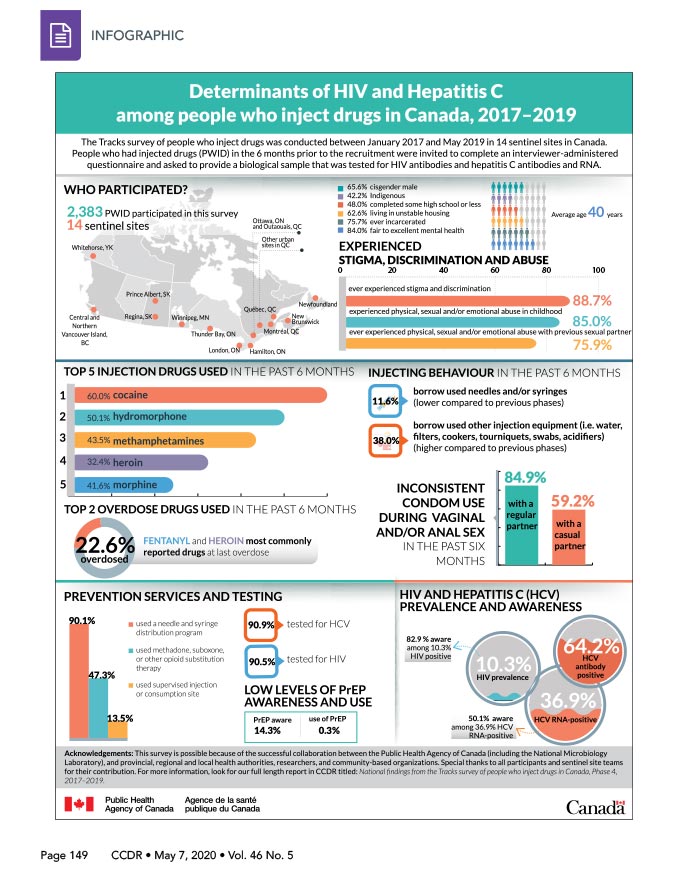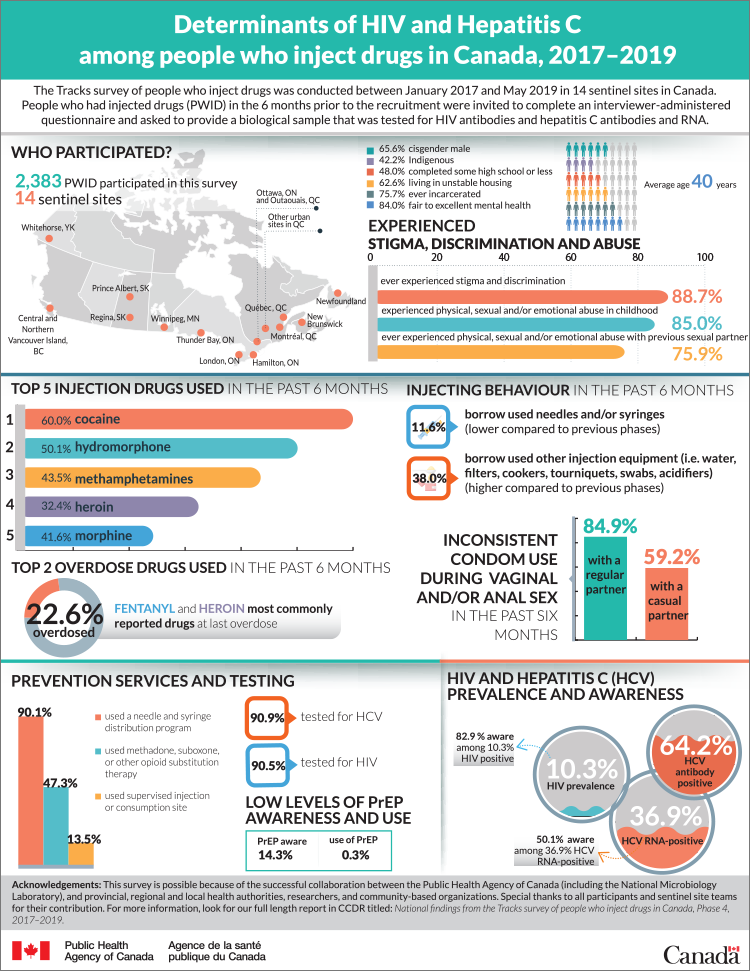Infographic on Tracks survey in Canada

 Download this article as a PDF
Download this article as a PDFPublished by: The Public Health Agency of Canada
Issue: Volume 46–5: Nosocomial infection surveillance
Date published: May 7, 2020
ISSN: 1481-8531
Submit a manuscript
About CCDR
Browse
Volume 46–5, May 7, 2020: Nosocomial infection surveillance
Infographic
Determinants of HIV and hepatitis C among people who inject drugs in Canada, 2017–2019

Text description: Infographic
Determinants of HIV and hepatitis C among people who inject drugs in Canada, 2017–2019
The Tracks survey of people who inject drugs was conducted between January 2017 and May 2019 in 14 sentinel sites in Canada. People who had injected drugs in the six months prior to recruitment were invited to complete an interviewer-administered questionnaire and asked to provide a biological sample that was tested for HIV antibodies and hepatitis C antibodies and RNA.
WHO PARTICIPATED?
A total of 2,383 individuals were eligible and consented to participate in the Phase 4 survey from 14 sentinel sites. These sites included: Whitehorse (Yukon), Central and Northern Vancouver Island (British Columbia), Prince Albert (Saskatchewan), Regina (Saskatchewan), Winnipeg (Manitoba), Thunder Bay (Ontario), London (Ontario), Hamilton (Ontario), Ottawa (Ontario) and the region of Outaouais (Quebec), Montréal (Quebec), Québec (Quebec), and other urban sites in the province of Quebec, New Brunswick, and Newfoundland. The average age was 40 years old. 65.6% were cisgender male, 42.2% were Indigenous, 48.0% had completed some high school or less, 62.6% were living in unstable housing, 75.7% were ever incarcerated and 84.0% reported fair to excellent mental health.
EXPERIENCED STIGMA, DISCRIMINATION AND ABUSE
The majority of participants experienced stigma and discrimination (88.7%) and physical, sexual and/or emotional abuse in childhood (85.0%) or ever with a sexual partner (75.9%).
INJECTION DRUGS AND OVERDOSE DRUGS USED IN THE PAST SIX MONTHS
The top five commonly injected drugs were cocaine (60.0%), hydromorphone (50.1%), methamphetamines (43.5%), morphine (41.6%) and heroin (32.4%). Nearly one-quarter of all participants (22.6%) had overdosed in the six months prior to the interview, with fentanyl and heroin reported as the most common drugs used at last overdose.
INJECTING BEHAVIOURS IN THE PAST SIX MONTHS
A small proportion of participants (11.6%) had borrowed used needles and/or syringes, which was lower compared to previous phases. Just over one-third (38.0%) borrowed used other injection equipment (e.g. water, filters, cookers, tourniquets, swabs, acidifiers), which was higher compared to previous phases.
SEXUAL RISK BEHAVIOURS IN THE PAST SIX MONTHS
A large proportion of participants (84.9%) had inconsistent condom use during vaginal and/or anal sex with a regular partner and more than half (59.2%) had inconsistent condom use during vaginal and/or anal sex with a casual partner.
PREVENTION SERVICES AND TESTING
The majority of participants (90.1%) reported using a needle and syringe distribution program in the 12 months prior to the interview. Lower proportions of participants reported use of methadone, suboxone or other opioid substitution therapy (47.3%) and use of a supervised injection or consumption site (13.5%). The majority of participants reported being ever tested for HIV (90.5%) and hepatitis C (90.9%).
LOW LEVELS OF PrEP AWARENESS AND USE
Some participants had heard of PrEP (14.3%) and among participants who did not report an HIV diagnosis, only 0.3% had used PrEP in the 12 months prior to the interview.
HIV AND HEPATITIS C PREVALENCE AND AWARENESS
HIV prevalence was 10.3% and of those who were HIV-positive, 82.9% were aware of their HIV-positive status. The proportion who tested positive for hepatitis C antibodies was 64.2%, which is a measure of lifetime exposure to hepatitis C infection. Many (36.9%) were hepatitis C RNA-positive—an indicator of current hepatitis C infection—of whom, half (50.1%) were aware of their hepatitis C RNA positive status.
ACKNOWLEDGEMENTS
The Tracks survey of people who inject drugs in Canada is possible because of the successful collaboration between the Public Health Agency of Canada (including the National Microbiology Laboratory), and provincial, regional and local health authorities, researchers, and community-based organizations. Special thanks to all participants and sentinel site teams for their contribution. For more information, look for our full-length report in CCDR titled: National findings from the Tracks survey of people who inject drugs in Canada, Phase 4, 2017–2019.
Page details
- Date modified:
